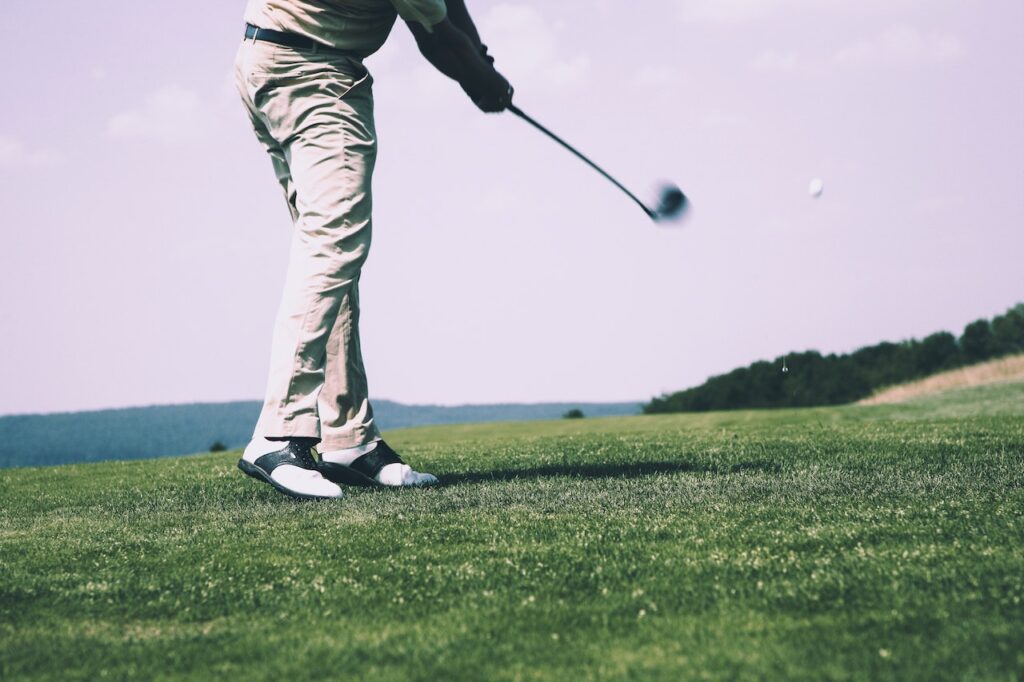Hello there, those of you who enjoy golf! Have you ever been curious about the number of calories that you burn when playing a game of golf? You’re in for a pleasant surprise, that’s for sure! Not only is golf a terrific method to burn calories, but it’s also a fun and relaxing activity to play.
In Short Answer Playing a full 18-hole round can burn up to 1,500 calories!
Here is a table summarizing the number of calories burned playing golf for different activities and weights:
| Activity | Weight (pounds) | Calories Burned per Hour |
|---|---|---|
| Walking and carrying clubs | 180 | 600 |
| Walking and using a push cart | 180 | 450 |
| Riding in a cart | 180 | 300 |
| Walking and carrying clubs | 200 | 720 |
| Walking and using a push cart | 200 | 540 |
| Riding in a cart | 200 | 360 |
Key Takeaways
- Calorie-Burning Potential: Golf is an effective way to burn calories, with a full 18-hole round burning up to 1,500 calories, similar to a high-intensity gym workout.
- Factors Affecting Calories Burned: Your weight, the course terrain, walking vs. riding in a cart, and carrying your bag all influence calorie expenditure during a round of golf.
- Equipment and Swing Impact: The weight of golf clubs, the type of swing, and even golf gloves and hats can affect calorie burn. Heavier clubs and full swings burn more calories.
- Health and Enjoyment: Golf not only offers physical benefits but also mental relaxation and stress relief in a serene outdoor environment, making it a fun way to stay fit and healthy.
Why is golf considered a form of exercise?

Golf is more than just swinging clubs and hitting balls. It involves walking, carrying your bag, and even strategizing your next move. All these activities contribute to burning calories. In fact, playing a full 18-hole round can burn up to 1,500 calories! That’s equivalent to a high-intensity workout at the gym.
Factors that influence calories burned while playing golf
So how many calories do you actually burn? It depends on several factors:
1.Your Weight: The more you weigh, the more calories you’ll burn.
2.The Course: A hilly course requires more energy than a flat one.
3.Walking or Riding: Walking the course burns more calories than riding in a golf cart.
4.Caddying: Carrying your own bag increases the calorie burn.
Here’s a quick table to summarize:
| Factor | Explanation |
|---|---|
| Your Weight | The heavier you are, the more calories you’ll burn. |
| The Course | A hilly course will require more energy (and thus burn more calories) than a flat one. |
| Walking or Riding | Walking the course instead of riding in a golf cart will significantly increase the number of calories burned. |
| Caddying | Carrying your own bag instead of using a caddy can also increase the calorie burn. |
So next time you’re out on the green, remember that not only are you having fun, but you’re also getting in some great exercise!
Calories Burned During a Round
Imagine this: you’re out on the course, taking in a round of golf, the sun is shining, and you’re working up a decent sweat without even realizing it. What could be better? That’s not a typo; you read that correctly! The sport of golf is not only a ton of fun to play, but it’s also a fantastic way to get some exercise.
Average calorie burn for walking 18 holes
What an unexpected turn of events! Walking all 18 holes of a golf course may be an effective way to burn a significant number of calories. While walking and playing golf, an individual who weighs 190 pounds may expect to burn roughly 431 calories per hour on average. That equates to a tremendous loss of 1,724 calories over the course of almost four hours, which is the typical amount of time required to walk all 18 holes.
Calories burned while carrying golf bags vs. using a push cart
How you choose to carry your clubs can also impact your calorie burn. Carrying your golf bag can help you burn around 721 calories in two hours. On the contrary, using a push cart might result in fewer calories burned – around 613 for the same duration. So, if you’re looking to maximize your workout, carrying your bag could be the way to go.
Effect of course terrain on calorie expenditure
The terrain of the golf course plays an important role too. A hilly course will require more energy and thus burn more calories compared to a flat one. So, next time you’re choosing a golf course, consider picking one with varied terrains for an extra calorie-burning boost.
Here’s a quick summary:
| Activity | Calories Burned (per hour for a 190-pound person) |
|---|---|
| Walking 18 holes | 431 |
| Carrying golf bag (2 hours) | 721 |
| Using push cart (2 hours) | 613 |
So remember, every swing counts not just for your scorecard but also for your health! Enjoy your game and stay fit!
Stay Hydrated and Eat Well: Don’t forget to stay hydrated on the golf course, especially on hot days. Proper hydration is essential for maintaining energy levels and preventing fatigue. Additionally, choose nutritious snacks or meals to fuel your game, such as fruit, nuts, or a balanced sandwich. Eating well helps sustain your energy throughout the round and enhances your overall golfing experience.
Calories Burned During Swing Practice

Hello there, golf aficionados!It is possible that you may be astonished to find out that not only is your favorite hobby enjoyable, but it is also an excellent way to get rid of extra calories. You did really hear it correctly! The game of golf is beneficial not only for improving one’s swing or decreasing one’s handicap, but also for maintaining one’s physical fitness and mental well-being.
Calories burned during a golf driving range session
Did you know? A golf driving range session can burn a significant number of calories. According to the Compendium of Physical Activities, a 155-pound person can burn approximately 211 calories per hour during a non-competitive golf driving range session. That’s equivalent to a 30-minute brisk walk or a 15-minute bike ride!
Different types of swings and their impact on calorie burn
Guess what? The type of swing you use can also impact the number of calories you burn. For instance, the classic golf swing, which involves a full rotation of the body, can burn more calories than a half swing or chip shot. This is because the classic golf swing engages more muscle groups, leading to higher energy expenditure.
Here’s a quick table to summarize:
| Type of Swing | Calories Burned (per hour for 155-pound person) |
|---|---|
| Classic Full Swing | Approximately 250 |
| Half Swing | Approximately 200 |
| Chip Shot | Approximately 150 |
So, next time you’re out on the green, remember that every swing is not just improving your game but also contributing to your fitness goals. Happy golfing!
Benefits of Walking vs. Riding in a Cart
Imagine the sun shining, birds chirping, and you’re out on the green, ready for a day of golf. But did you know that this leisurely activity could also be a calorie-burning exercise? Yes, you heard it right! Golf can be a fun way to stay active and fit.
Calories burned while walking vs. riding a golf cart
Let’s talk numbers. When you choose to walk the course instead of riding in a golf cart, you’re not only enjoying the beauty of the outdoors but also burning extra calories. A golfer who opts to walk can burn up to 1,400 calories during an 18-hole round, while someone riding in a cart might burn around 800 calories. That’s almost double the calorie burn!
Improving fitness and cardiovascular health through walking
But wait, there’s more! Walking the golf course isn’t just about burning calories. It’s also an excellent way to improve your overall fitness and cardiovascular health. Walking for 18 holes is equivalent to a 5-mile walk or a 3.5 to 4-mile run. This kind of physical activity can help lower your risk of heart disease, stroke, and diabetes.
Here’s a quick comparison table:
| Activity | Calories Burned | Health Benefits |
|---|---|---|
| Walking the Golf Course | Up to 1,400 | Improves overall fitness and cardiovascular health |
| Riding in a Golf Cart | Around 800 | Limited physical activity |
So next time you’re planning a golf outing, consider ditching the cart and walking instead. Not only will you enjoy the game and surroundings more, but you’ll also be doing something good for your health!
Impact of Golf Equipment on Calorie Burn

Imagine this: You’re standing on the lush green fairway, golf club in hand, ready to take that winning swing. You’ve probably never thought of golf as a calorie-burning exercise. But guess what? It is!
Effect of using lightweight vs. heavy clubs on calorie expenditure
Lightweight vs. Heavy Clubs: You might be thinking, “Does the weight of my golf club affect how many calories I burn?” Well, the answer is yes! Swinging a heavier club requires more energy, thus burning more calories. But don’t rush to swap your lightweight clubs for heavier ones just yet. Remember that a heavier club might make your swing slower and less accurate. It’s all about finding the right balance for you.
Do wearing a golf glove or using a golf hat affect calorie burn?
Golf Gloves and Hats: Now, let’s talk about golf gloves and hats. While they might not directly impact the number of calories you burn, they do play a role in your overall comfort and performance on the course. A good golf glove can improve your grip, reducing the chance of blisters and ensuring you can play for longer. A hat can protect you from the sun, keeping you cool and focused. The longer you play, the more calories you burn!
Here’s a quick look at how different equipment can impact your calorie burn:
| Equipment | Impact on Calorie Burn |
|---|---|
| Lightweight Clubs | Less energy required to swing, therefore fewer calories burned |
| Heavy Clubs | More energy required to swing, therefore more calories burned |
| Golf Gloves | Improves grip and comfort, enabling longer play and potentially more calorie burn |
| Golf Hat | Provides sun protection, keeping you cool for extended play and potentially more calorie burn |
So next time you’re out on the course, remember that every swing is not just getting you closer to that hole-in-one but also helping you stay fit and healthy!
Calories Burned During Golf Lessons or Coaching
Who says golf is just a leisurely sport? You might be surprised to find out that it’s not just your golf skills that get a workout during a game, but your body does too!
Calories burned during one-on-one coaching sessions or golf lessons
Let’s talk about your golf lessons or coaching sessions. You might be thinking, “I’m not really doing much, just swinging a club.” But guess what? You’re burning calories! On average, an hour-long one-on-one golf lesson can burn between 200-300 calories. This number can vary depending on factors like your weight, age, gender, and intensity of the lesson.
The added benefit of physical activity during practice sessions
But wait, there’s more! When you’re out there on the green practicing your swing or working on your putting skills, you’re also getting in some physical activity. Walking from hole to hole, carrying your golf bag, and even the act of swinging can contribute to calorie burn. In fact, a round of golf can burn up to 1,000 calories!
So next time you’re heading out for a round of golf or a coaching session, remember that you’re not just working on your game – you’re also getting in a great workout!
Here’s a quick summary:
| Activity | Calories Burned |
|---|---|
| One-on-one Golf Lesson (1 hour) | 200-300 |
| Round of Golf | Up to 1,000 |
So go ahead and enjoy that game of golf, knowing that you’re also doing something good for your body
Calories Burned During Golf Practice at Home

Hey there, golf enthusiast! You might be surprised to learn that practicing golf at home is not just a fun way to improve your game, but it’s also a sneaky way to burn some calories.
Calories burned during putting practice at home
Putting practice might not seem like much of a workout, but it does burn calories. In fact, a 150-pound person can burn approximately 90 calories per half hour of putting. That’s not bad for an activity that you can do while watching your favorite show!
Calories burned while using a golf simulator or practicing swings indoors
If you want to burn even more calories, try using a golf simulator or just practicing your strokes inside. If you weigh 150 pounds, you may expect to burn around 200 calories in every half hour that you engage in this more strenuous activity. You should keep this in mind the next time you’re having fun swinging in the living room: in addition to having fun, you’re also getting a good workout.
Here’s a quick look at the calorie burn you can expect from at-home golf practice:
| Activity | Calories Burned (per half hour for 150-pound person) |
|---|---|
| Putting Practice | 90 |
| Golf Simulator/Swing Practice | 200 |
So, don’t underestimate the power of home golf practice. Not only are you improving your swing, but you’re also burning calories and staying active. Now that’s what we call a hole-in-one!
Practical Tips for Maximizing Calorie Burn on the Golf Course
Golf, a sport often associated with leisure and relaxation, can also be a great way to burn calories. While it may not seem like the most strenuous activity, the truth is that a round of golf can burn a significant number of calories. This is especially true if you choose to walk the course instead of using a cart.
Increasing intensity through brisk walking or jogging between holes
Step up your game and increase the intensity of your golf round by brisk walking or even jogging between holes. This not only gets your heart rate up but also helps to burn more calories. According to a study by Neil Wolkodoff, a medical program director at the Rose Center for Health and Sports Sciences in Denver, golfers who walk and carry their own clubs burn up to 721 calories over nine holes. That’s impressive!
Opt for manual labor: Consider carrying your own clubs instead of using a golf cart or caddie. This will increase the physical demand of the game, leading to higher calorie expenditure.
Practice your swing: Believe it or not, practicing your swing can also burn calories. Each swing uses multiple muscle groups in your body, which in turn burns calories.
Here’s a table summarizing how you can maximize calorie burn while playing golf:
| Activity | Calories Burned (per nine holes) |
|---|---|
| Walking and carrying clubs | 721 |
| Using a push cart | 718 |
| Using a caddy | 613 |
| Riding in a golf cart | 411 |
Remember, every little bit counts when it comes to burning calories. So next time you hit the greens, consider these tips to make your golf game a more effective workout!
How to calculate burned calories?
There are a few different formulas that can be used to calculate the number of calories burned while playing golf. One common formula is:
Calories burned per hour = (MET x bodyweight in kg x 3.5) ÷ 200
where:
- MET (metabolic equivalent of task) is a measure of the intensity of physical activity. Golf has a MET value of 4.8, which is considered to be moderate-intensity exercise.
- Bodyweight in kg is your weight in kilograms.
For example, a 155-pound (70-kilogram) person who walks and carries their clubs while playing golf would burn about 200 calories per hour.
Another formula that can be used is:
Calories burned per minute = (MET x bodyweight in kg x 5) ÷ 200
This formula can be used to calculate the number of calories burned per minute, rather than per hour.
To calculate the total number of calories burned for a round of golf, you can multiply the number of calories burned per hour by the number of hours spent playing. For example, a 155-pound person who walks and carries their clubs for 4 hours would burn about 800 calories.
It is important to note that these are just estimates and the actual number of calories burned will vary depending on a number of factors, such as your fitness level, the course conditions, and how much you are actually moving around.
final thoughts
You’ve had an exciting day on the golf course, and you’re probably wondering, “How many calories did I burn?” Well, you’ll be thrilled to know that golfing is not only a fun sport but also an excellent way to burn calories!
Summary of calories burned
Yes, you heard it right! Golfing can help you maintain a healthy lifestyle. The number of calories burned while playing golf depends on several factors, including your weight, the intensity of the game, and whether you’re walking or using a cart.
If you’re walking: An average golfer weighing around 190 pounds can burn approximately 431 calories per hour. If you’re lighter, say 150 pounds, you can still burn around 330 calories per hour!
If you’re using a cart: Even if you opt for a cart, it’s not all relaxation and no work. A golfer weighing 190 pounds can expect to burn around 295 calories per hour, while a 150-pound golfer can burn about 240 calories.
So next time when you’re out on the course, remember that each swing, walk to the next hole or even driving the cart contributes to your daily calorie burn. Keep swinging and enjoy the dual benefits of playing golf – having fun and staying fit!
Here’s a table summarizing how many calories you can burn playing golf:
| Activity | Calories Burned (per hour) for 150 lbs | Calories Burned (per hour) for 190 lbs |
|---|---|---|
| Walking | 330 | 431 |
| Using Cart | 240 | 295 |
So go ahead, enjoy your game of golf and keep burning those calories!
My Personal Experience
I am able to speak from personal experience when it comes to the topic of burning calories through the game of golf. As someone who plays golf frequently, I can attest to the fact that participating in this activity may unquestionably assist you in shedding some of those excess pounds.
My normal walking distance for a game of golf with 18 holes is around 5 kilometers. Walking the course is an excellent way to increase your cardiovascular fitness and burn calories at the same time. During a game of golf, I usually end up burning between 1,000 and 1,300 calories on average. This figure might change based on a variety of circumstances, including the terrain and the effort level you set for yourself.
In addition to this, the motion of swinging the golf club itself is a form of physical activity. Every time you swing, you’re working a variety of different muscle groups, including those in your core, arms, and legs. I am easily capable of making hundreds of swings during the course of a round, which contributes to the total number of calories that I burn.
It goes without saying, but it’s essential to keep in mind that the amount of calories burnt by playing golf varies greatly from one individual to the next. When it comes to calculating the precise number of calories burnt, a number of other factors come into play, including age, weight, and fitness level.
In my experience, playing golf not only has positive effects on one’s physical health but also has a calming effect on one’s mind. The peaceful atmosphere of the golf course, along with the strenuous nature of the game, can be an effective means of relieving stress.
Consequently, if you are searching for a fun method to burn calories and spend some time outside, you might want to think about picking up the sport of golf. A healthy mind and body are both benefits that may be gained through participating in this activity.

I’m Donna Weiss, and I am the proud writer behind the captivating content you’ll find on golfneedy.com. As an avid golfer and passionate writer, I have combined my two greatest passions to bring you an incredible golfing experience. Through my articles, I aim to provide you with valuable insights, equipment reviews, and updates on the latest tournaments. Whether you’re a seasoned golfer or just starting out on this exciting journey, I am here to guide you and share my expertise. Together, let’s explore the fascinating world of golf, uncovering new techniques, and enhancing our skills. Join me on this thrilling adventure as we elevate our game and embark on an exciting golfing journey. Read More



